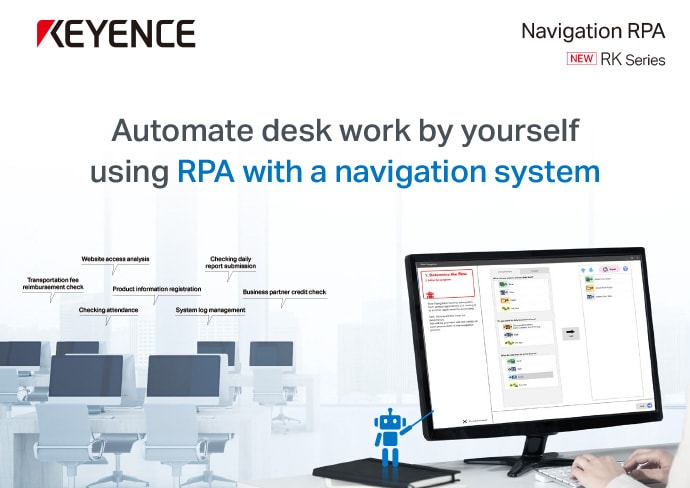Chukyo University
Through implementing RK across 15 different departments within the university headquarters, we have successfully achieved an annual reduction of 713 hours in total workload. We highly recommend RK, not only for universities, but also for any organization with similar routine-heavy operations.
Chukyo University, under the Umemura Gakuen Educational Institution, has significantly streamlined its operations by implementing KEYENCE's Robotic Process Automation (RPA) tool, RK. This initiative, a core component of the university's "DX Promotion Project," aims to accelerate digital transformation across its various departments.
To delve deeper into the background of RK's implementation, the reasons behind its selection, and tips for effective cross-departmental deployment, we spoke with Mr. Nishiguchi, Assistant Manager of the Finance Section in the Finance Department (formerly Assistant Manager of the Information Systems Section in the Academic Information Systems Department), and Mr. Yamashita from the Information Systems Section in the Academic Information Systems Department.
Chukyo University
With two campuses in Nagoya and Toyota , Chukyo University is a comprehensive institution with 20 educational departments, hosting over 13,000 students.
Celebrating its 70th anniversary in 2024, the university boasts a network of over 140,000 alumni who are making significant contributions across various fields. As one of the leading universities in the Chubu region, Chukyo University leverages its scale to offer robust educational systems, study abroad opportunities, professional certification programs, teacher training, and career support initiatives. Above all, the dynamic energy and potential of its students are what truly define the university's appeal.
- Founded: 1954
- Number of employees: 580 (Full-time Faculty: 363, Staff: 217)
Utilizing RK across 15 departments within the university headquarters
Could you please tell us about how you are utilizing RK?
RK was introduced in June of 2023, initially utilized by only three departments: Finance, Human Resources, and the General Affairs Department. Less than a year later in May of 2024, it was expanded to all departments of the university.
As of now, there are 35 active scenarios (automation programs) used daily to aid in the efficiency and success of operations. Here are a few examples of the scenarios in production:
- Finance: Tuition Collection Operations – Automating the process from transferring tuition summary tables (Excel) generated by the core administrative system into the accounting system, to outputting payment and transfer slips.
- Human Resources: Changes, Additions, and Deletions in HR Information – Automatically reflecting changes in personnel data into the payroll system using RK.
- General Affairs: Aggregating Safety Confirmation Responses – Using RK to compile response data from the student portal, including the number of responses and response rates.
- Library: Updating Subscription Materials – Automating the update of master data for serial publications and subscription materials using RK.
These tasks were previously tedious and prone to errors when handled manually. Through automation, these processes have become significantly easier and more efficient.
Deciding to Introduce RPA as Part of the DX Promotion Initiative
What led to the decision to implement RPA?
The initial trigger for adopting RPA was the launch of the "DX Promotion Project," a key tech-forward initiative outlined in our university's long-term plan. This project identified several areas for digital transformation, including the introduction of chatbots, digitization of various application processes, utilization of generative AI, and the implementation of RPA.
To explore options, we attended IT-related exhibitions and shortlisted three RPA tools, including RK. We reached out to each vendor and conducted trial implementations to evaluate their suitability.
During this trial phase, we assessed each RPA tool based on four key criteria: "cost," "functional compatibility," "implementation track record," and "usability." RK stood out significantly in each of these areas, earning the highest overall evaluation and ultimately being selected for implementation.
What specific tests were conducted, and what aspects were evaluated?
We tested the automation of transferring data from Excel to various web-based systems. Staff members who interacted with the tools particularly praised RK for the following reasons:
- Quick and Easy Automation
RK's "Activity" feature, which allows users to develop scenarios simply by selecting desired actions step-by-step from a menu, was highly rated for its convenience. It enables anyone to quickly and easily achieve automation. Additionally, RK had a lower error rate compared to other tools, which was another major advantage and influencing factor in our selection of this tool. - User-Friendly Interface
The interface is color-coded making it approachable and easy to navigate. For example, loop processing is labeled with phrases like "Repeat XX," written in language that even those without programming knowledge can understand. This makes scenario creation accessible to everyone. - Automatic Data Conversion from Excel
RK includes a "Key Database" feature that automatically analyzes and converts imported Excel files into a database format. The ability to transform data without specific instructions was incredibly convenient. - Comprehensive Self-Learning Resources
RK's support site offers a wealth of resources, including manuals and e-learning videos. The abundance of self-learning materials proved invaluable when expanding RK's use across multiple departments.
Achieving an Annual Reduction of 713 Work Hours in Just 1.5 Years Since Implementation!
What are the benefits of the implementation?
In just 18 months years since implementation, we have developed 35 automation scenarios, leading to an annual reduction of 713 work hours. As RK has only recently been rolled out to some departments, there is still significant potential for expansion and further automation, even within the departments that were early adopters of the tool. We anticipate that this reduction in work hours will continue to grow in the future.
One major factor contributing to the progress in automation has been the simultaneous advancements made through the "DX Promotion Project," including the digitization of various application processes and the utilization of generative AI. The transition from paper-based documents, such as proposal forms and application forms, to digital formats has created more opportunities to leverage RK. Additionally, we’ve discovered new ways to integrate RK with tools like Excel macros created by generative AI, further enhancing automation capabilities.
The DX initiative has not only facilitated RK-driven automation but also prompted a broader reevaluation of workflows, leading to greater efficiency across the board. This has significantly eased the workload for staff members.
What kind of workflows were reevaluated?
One notable example is the approval process for documentation. Previously, documents were paper-based, and often followed overly complex approval routes. This involved an excessive number of managers simply because it followed a traditional format of chain-link approval. By reassessing questions such as, "Why is this person involved?" and "Does this information need to reach them?" we streamlined the approval process, reducing the number of people involved to an appropriate level. This has made the flow of application approvals much smoother.
Chukyo University has successfully deployed RK across 15 departments. What strategies were employed to ensure smooth and effective cross-departmental implementation?
Here are three key points:
Guiding Self-Learning
While RK’s support site is rich with resources, beginners often feel overwhelmed and unsure of where to start. To address this, we pinpointed specific videos that new users should watch first and provided clear guidance, saying, "Start with these." This helped users kick off their learning journey smoothly and confidently.
Assigning RK Representatives in Each Department
We requested department heads to appoint an "RK representative" within their teams. This approach encouraged the representatives to take ownership of RK implementation, treating it as their personal responsibility. From the perspective of the Information Systems Section, it also allowed us to directly engage with these representatives, making it easier to drive adoption and usage within each department.
Creating Modular Scenario Components
RK scenarios can be partially reused in other scenarios. To leverage this, we identified common tasks, such as "downloading application forms" or "logging into the core system," and organized them into shared folders as reusable "modules." By simply combining these pre-made components, staff members could achieve automation with minimal effort. This approach not only empowered them to feel a sense of accomplishment—"I did it myself!"—but also encouraged more frequent use of RK.
From the perspective of the Information Systems Section, which supports RK implementation, the success of RK’s deployment ultimately depends on the efforts of the staff on the ground. Moving forward, we aim to continue providing support that ensures users don’t feel frustrated or discouraged by RPA, expanding beyond these three strategies as needed.
Of course, the smooth expansion of RK is also thanks to the tool’s inherent user-friendliness. Most of our staff have no prior experience with programming. RK’s intuitive design and robust support make it approachable, encouraging even first-time users to give it a try. This ease of use is a key factor in RK’s appeal.
High Praise for Accompanying Support: Exceptional Understanding, Problem-Solving, and Quality Advice
Since the topic of support has come up, could you share your evaluation of the accompanying support provided?
We hold the accompanying support in very high regard, particularly for its exceptional understanding and quick response. Even when discussing our university’s core administrative system—a tool that is far from standard—the support team immediately grasps the context and offers solutions on the spot. This has been incredibly helpful.
Moreover, they don’t just provide a single solution; they often present multiple approaches to achieve the same result. This has led to moments of discovery, where we think, "Oh, there’s another way to do this!"
Additionally, their advice extends beyond RK-specific solutions. For instance, they might suggest Excel shortcuts or other tips, saying, "This method will save you time." These insights are not only practical but also genuinely engaging, making the support sessions enjoyable to participate in.
When we receive remote accompanying support, we notify all RK representatives across departments, allowing anyone interested to join. This openness has led to instances where staff from other departments join simply because they find the sessions intriguing and want to learn more.
Toward Further Utilization of RK
Based on your experience using RK extensively within the university, would you recommend it to other organizations?
Absolutely, we highly recommend RK. Not only for universities but also for organizations like city halls and prefectural offices. These institutions often share similar tasks, such as certificate issuance, and have a significant amount of routine work. We frequently draw inspiration from each other’s operations, making RK a valuable tool for streamlining such processes.
What are your future plans for RK?
In the short term, we aim to increase the number of scenarios and expand RK’s operational hours, including in departments that have only recently started using it.
On a broader scale, we hope to deepen RK understanding across all staff members within the university. Currently, RK is primarily handled by the designated representatives in each department, as mentioned earlier. While this approach has been effective, it also means that automation capabilities are limited by the representatives’ level of experience. Less experienced representatives may lack in-depth knowledge of their department’s operations or how to collaborate with other departments, which restricts the scope of tasks that can be automated.
To address this, we plan to organize digital literacy workshops for all staff members. While not everyone needs to actively use RK, we want to empower all staff to recognize opportunities for automation and propose ideas like, "This task might be automatable."
If we do host such workshops, we would greatly appreciate KEYENCE’s support in some capacity. For example, sharing insights like "This is how far general businesses have advanced in automation", would help our staff visualize the potential applications of RK and further encourage its adoption.

Navigation RPA RK Series
View Catalog
